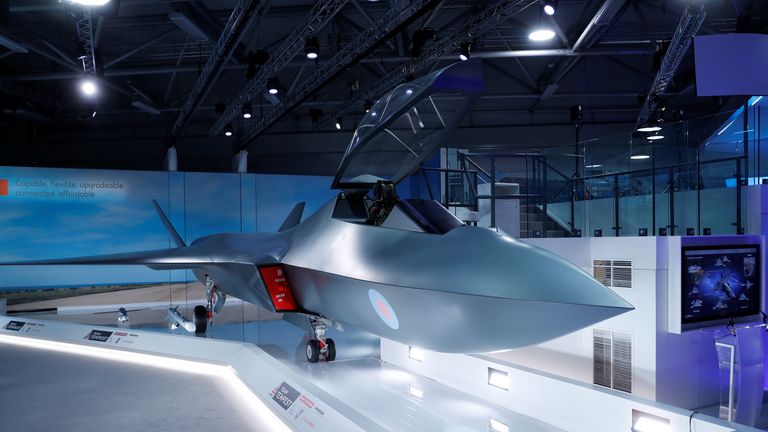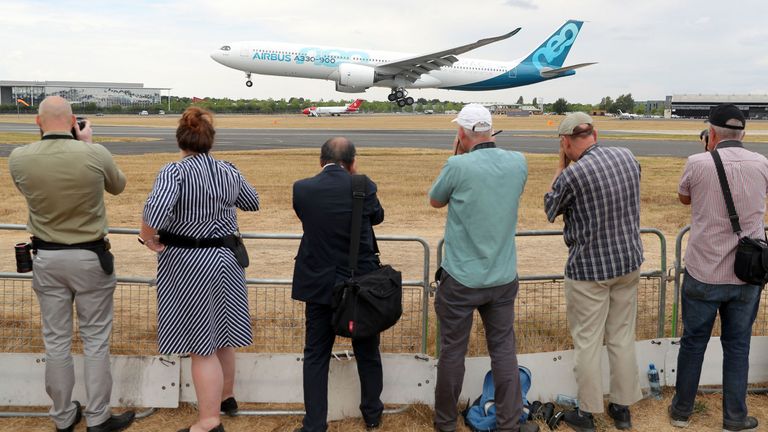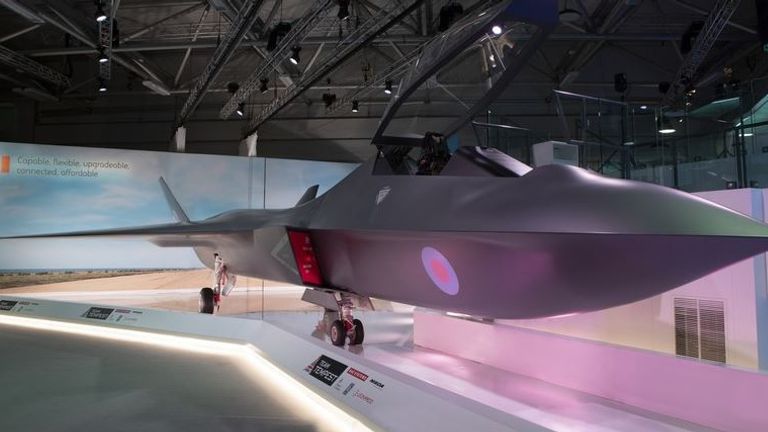Jackson_Slugger
$50 Site Donor 2022
Team Tempest fighter must have another big partner in its sights
Sky's Ian King says progress in the Team Tempest project is crucial for the country's defence sector and the jobs it supports.
Ian King
Business presenter @iankingsky
Monday 20 July 2020 17:04, UK

Image:A model of Tempest was first shown off at Farnborough two years ago
And, most importantly, it would have seen immensely busy air traffic in the skies above Hampshire.
Because today would have seen the biannual Farnborough International Airshow, the second-largest event of its kind in the world, in full swing.
Executives from the global aerospace sector, both civil and defence, would have rubbed shoulders with politicians, financiers and journalists. Deals would have been done. Others, totalling billions of pounds, would have been unveiled.

Image:The last Farnborough International Airshow was held in 2018
The last event, in 2018, saw nearly £150bn worth of contracts announced.
The event, which in the past is where iconic aircraft such as Concorde, the Eurofighter Typhoon and the Airbus A380 have been launched, showcases Britain's expertise and world-leading position in a key strategic industry.
Its cancellation this year, due to COVID-19, is merely the latest blow to a sector already been laid low by the pandemic.
Yet the event has still been taking place, albeit in a virtual setting, with key announcements on Monday concerning the UK's planned sixth-generation fighter jet.
It was at Farnborough two years ago that Tempest, the intended successor to the Typhoon, was first unveiled.
Led by Britain's two premier engineering companies, BAE Systems and Rolls-Royce, the consortium - Team Tempest - building the fighter-bomber also included the European missile developer MBDA.
The unveiling thrilled the industry. Aerospace is one of the UK's most important export earners and Tempest promises to secure many thousands of highly-skilled and well-paid jobs over the next two decades as well as thousands more in the supply chain.
Tempest was, arguably, born out of the Brexit vote.

Image:A decision about how many jets there will be is due to be made in 2015
The Typhoon is due to be phased out in the late 2030s and early 2040s and the UK had originally envisaged building as its successor an Anglo-French jet fighter in a consortium led by BAE Systems and Dassault Aviation, the French aerospace giant, which is best known for its Rafale jet fighter.
After the UK voted to leave the EU, France announced plans instead to build its next generation fighter jet in partnership with Germany, with Dassault joining forces with Airbus - one of the partners in building the Typhoon. The Spanish government subsequently announced it would be joining the project.
So Tempest also marked Britain's determination to build a next generation jet fighter of its own.
The announcement did not go down well in some European capitals as it was taken as a sign of weakening European defence co-operation.
Emmanuel Macron, the French president, grumbled at last year's Paris Air Show: "Competition amongst Europeans, when it weakens us against the Americans, the Chinese, is ridiculous."
Accordingly, Team Tempest has sought to bring in other partners and other governments. Shortly after the unveiling at Farnborough, it was announced that Leonardo, the Italian parent company of helicopter maker Agusta Westland, would be joining Team Tempest. So too did Saab, Sweden's leading defence contractor, but other partnerships have to date failed to materialise.
Monday, then, was an opportunity to show that Tempest still has momentum.
Ben Wallace, the Defence Secretary, used the virtual Farnborough to confirm that seven new companies had signed agreements to collaborate on Team Tempest.

Image:The aircraft is not due to enter service until 2035
They are the UK arms of the US industrial giant GE, the US aircraft parts maker Collins Aerospace and the French electrical systems group Thales - a key partner in the construction of the Royal Navy's new aircraft carriers - and the Canadian engineer Bombardier. They also include three domestic players: the aerospace engineering group GKN, the ejector seat maker Martin-Baker and the defence technology group Qinetiq.
Mr Wallace said that Team tempest had already devised a ground-breaking piece of technology by devising a generator that delivers unprecedented levels of electrical power.
He added: "Just two years after Team Tempest was created they delivered a world first. It's no surprise; when you attract the very best of British engineering and design, technological leaps like these are guaranteed.
"That's why I'm delighted seven more companies have joined this mission to work in collaboration with the MoD, under the Team Tempest banner. They will bring the ambition, invention and expertise that will deliver the breakthroughs we will depend on for decades to come.
"These pioneers will strengthen our ability to develop a next generation aircraft and allow us to continue making vital contributions to UK, European and global security."
Separately, Saab - which is best-known for manufacturing the Gripen fighter jet - announced it will invest an initial £50m opening a new centre to develop air combat technology, highlighting a deepening of its commitment to Tempest.
The location of the site has not been confirmed but is expected to be close to the existing BAE Systems Tempest teams in Lancashire.
The big question remaining, though, is whether manufacturers from other nations will join Team Tempest.
Japan has yet to decide on what will replace its existing jet fighter programme, the Mitsubishi F-2, with the Japanese Ministry of Defence holding talks with both its British And American counterparts in recent months about a possible collaboration.
Turkey, which was last year kicked out of the consortium led by US giant Lockheed-Martin building the new F-35 stealth fighter jet after buying Russian-made air defence systems,, has also been mooted as a possible partner. So has Australia.
Bringing in another partner - particularly Japan - would really show that the project is flying.
SKY News
Sky's Ian King says progress in the Team Tempest project is crucial for the country's defence sector and the jobs it supports.
Ian King
Business presenter @iankingsky
Monday 20 July 2020 17:04, UK

Image:A model of Tempest was first shown off at Farnborough two years ago
And, most importantly, it would have seen immensely busy air traffic in the skies above Hampshire.
Because today would have seen the biannual Farnborough International Airshow, the second-largest event of its kind in the world, in full swing.
Executives from the global aerospace sector, both civil and defence, would have rubbed shoulders with politicians, financiers and journalists. Deals would have been done. Others, totalling billions of pounds, would have been unveiled.

Image:The last Farnborough International Airshow was held in 2018
The last event, in 2018, saw nearly £150bn worth of contracts announced.
The event, which in the past is where iconic aircraft such as Concorde, the Eurofighter Typhoon and the Airbus A380 have been launched, showcases Britain's expertise and world-leading position in a key strategic industry.
Its cancellation this year, due to COVID-19, is merely the latest blow to a sector already been laid low by the pandemic.
Yet the event has still been taking place, albeit in a virtual setting, with key announcements on Monday concerning the UK's planned sixth-generation fighter jet.
It was at Farnborough two years ago that Tempest, the intended successor to the Typhoon, was first unveiled.
Led by Britain's two premier engineering companies, BAE Systems and Rolls-Royce, the consortium - Team Tempest - building the fighter-bomber also included the European missile developer MBDA.
The unveiling thrilled the industry. Aerospace is one of the UK's most important export earners and Tempest promises to secure many thousands of highly-skilled and well-paid jobs over the next two decades as well as thousands more in the supply chain.
Tempest was, arguably, born out of the Brexit vote.

Image:A decision about how many jets there will be is due to be made in 2015
The Typhoon is due to be phased out in the late 2030s and early 2040s and the UK had originally envisaged building as its successor an Anglo-French jet fighter in a consortium led by BAE Systems and Dassault Aviation, the French aerospace giant, which is best known for its Rafale jet fighter.
After the UK voted to leave the EU, France announced plans instead to build its next generation fighter jet in partnership with Germany, with Dassault joining forces with Airbus - one of the partners in building the Typhoon. The Spanish government subsequently announced it would be joining the project.
So Tempest also marked Britain's determination to build a next generation jet fighter of its own.
The announcement did not go down well in some European capitals as it was taken as a sign of weakening European defence co-operation.
Emmanuel Macron, the French president, grumbled at last year's Paris Air Show: "Competition amongst Europeans, when it weakens us against the Americans, the Chinese, is ridiculous."
Accordingly, Team Tempest has sought to bring in other partners and other governments. Shortly after the unveiling at Farnborough, it was announced that Leonardo, the Italian parent company of helicopter maker Agusta Westland, would be joining Team Tempest. So too did Saab, Sweden's leading defence contractor, but other partnerships have to date failed to materialise.
Monday, then, was an opportunity to show that Tempest still has momentum.
Ben Wallace, the Defence Secretary, used the virtual Farnborough to confirm that seven new companies had signed agreements to collaborate on Team Tempest.

Image:The aircraft is not due to enter service until 2035
They are the UK arms of the US industrial giant GE, the US aircraft parts maker Collins Aerospace and the French electrical systems group Thales - a key partner in the construction of the Royal Navy's new aircraft carriers - and the Canadian engineer Bombardier. They also include three domestic players: the aerospace engineering group GKN, the ejector seat maker Martin-Baker and the defence technology group Qinetiq.
Mr Wallace said that Team tempest had already devised a ground-breaking piece of technology by devising a generator that delivers unprecedented levels of electrical power.
He added: "Just two years after Team Tempest was created they delivered a world first. It's no surprise; when you attract the very best of British engineering and design, technological leaps like these are guaranteed.
"That's why I'm delighted seven more companies have joined this mission to work in collaboration with the MoD, under the Team Tempest banner. They will bring the ambition, invention and expertise that will deliver the breakthroughs we will depend on for decades to come.
"These pioneers will strengthen our ability to develop a next generation aircraft and allow us to continue making vital contributions to UK, European and global security."
Separately, Saab - which is best-known for manufacturing the Gripen fighter jet - announced it will invest an initial £50m opening a new centre to develop air combat technology, highlighting a deepening of its commitment to Tempest.
The location of the site has not been confirmed but is expected to be close to the existing BAE Systems Tempest teams in Lancashire.
The big question remaining, though, is whether manufacturers from other nations will join Team Tempest.
Japan has yet to decide on what will replace its existing jet fighter programme, the Mitsubishi F-2, with the Japanese Ministry of Defence holding talks with both its British And American counterparts in recent months about a possible collaboration.
Turkey, which was last year kicked out of the consortium led by US giant Lockheed-Martin building the new F-35 stealth fighter jet after buying Russian-made air defence systems,, has also been mooted as a possible partner. So has Australia.
Bringing in another partner - particularly Japan - would really show that the project is flying.
SKY News
